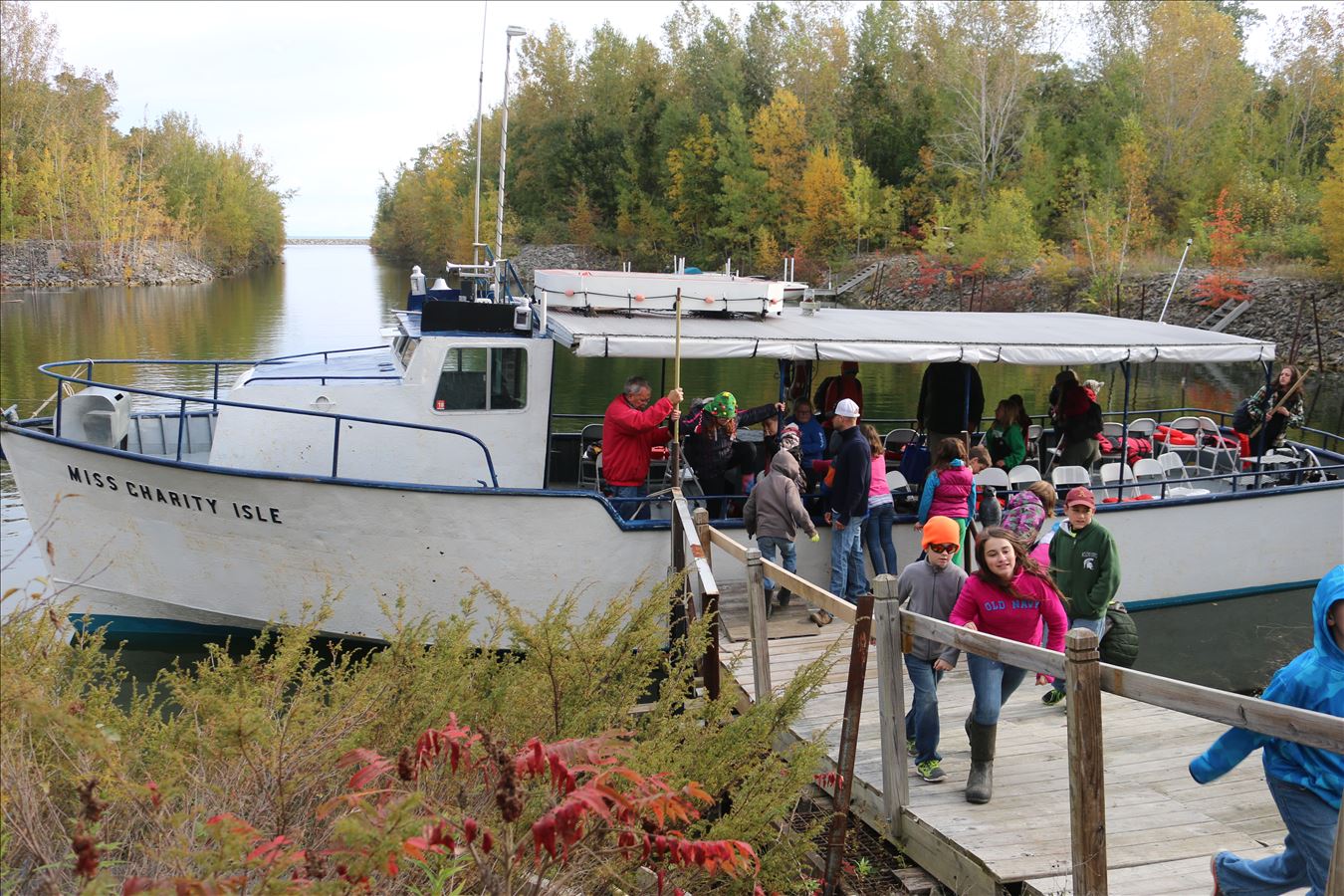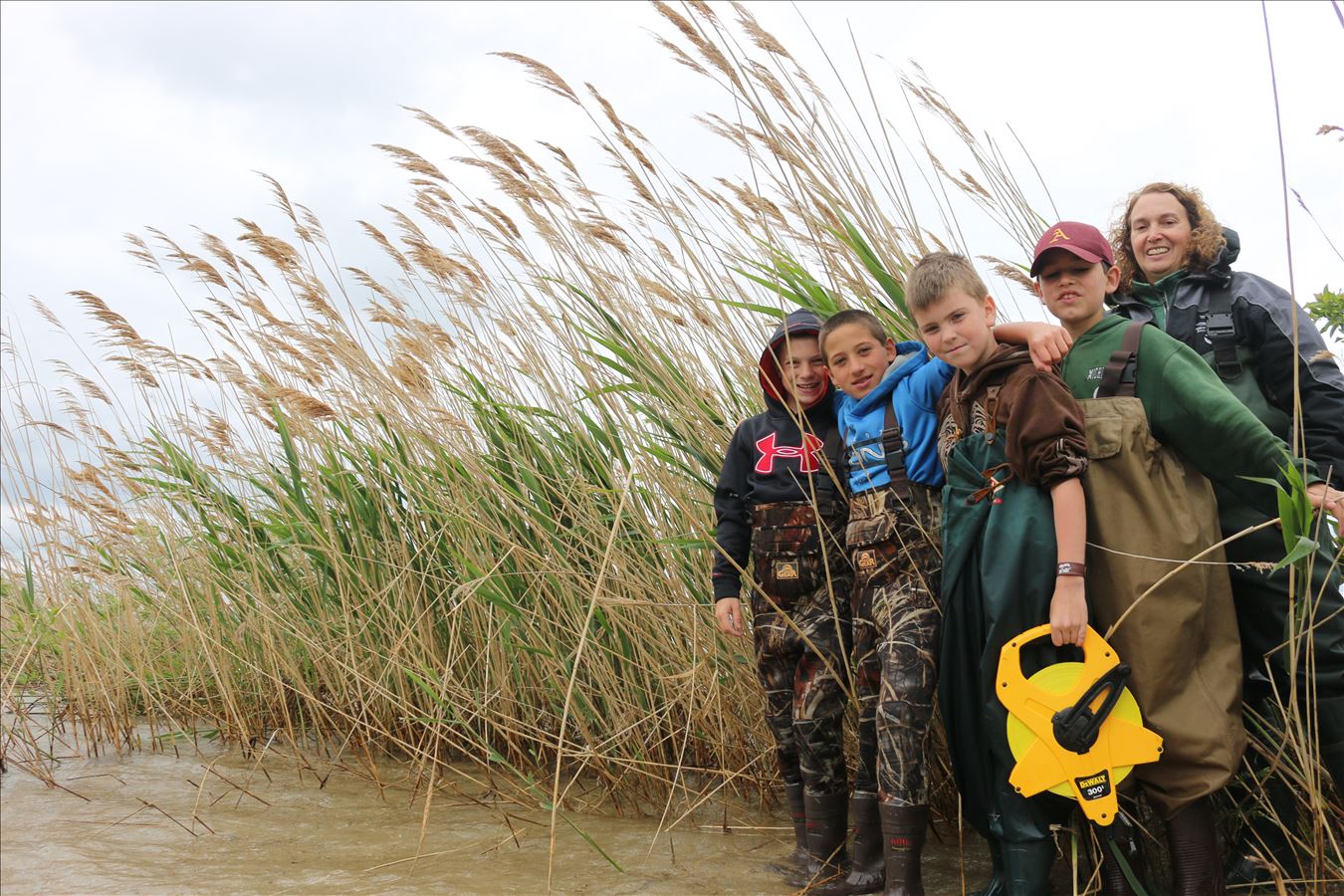Au Gres-Sims students have been taking the boat to Big Charity Island in Saginaw Bay to bolster a small surviving population of Pitcher’s thistle, a threatened plant that grows on beaches and dunes along Lakes Superior, Huron and Michigan. The work is coupled with efforts by the Shiawassee National Wildlife Refuge, Huron Pines, Michigan Sea Grant and Michigan State University (MSU) Extension to remove an invasive plant called Phragmites and hopefully return the thistle to habitat near Au Gres where it’s been extirpated.
The district started its environmental stewardship initiative in the fall of 2013, said Superintendent Jeff Collier. Thanks to grants and support from outside organizations, the district was able to provide students with gear to wade into the Au Gres River to test water quality samples and collect bugs, aquatic insects, and other tiny creatures. The students were able to get a firsthand look at soil erosion studies and how to use insects as an indicator of water quality, working with scientists and staff from the Northeast Michigan Great Lakes Stewardship Initiative (NEMIGLSI), which in turn put them in touch with the Alpena office of the US Fish and Wildlife Service (USFWS), MSU and Huron Pines to use the data and make it available via National Geographic's FieldScope citizen science program.
Collier wanted to see the stewardship program be sustainable year after year, which led to partnerships with scientists throughout Saginaw Bay. Ultimately, he said, this led to a connection with the Shiawassee refuge office and its wildlife refuge on Big Charity Island, which is technically within the school district’s boundaries alongside the smaller Little Charity Island.
Little Charity Island and most of Big Charity Island are part of Michigan Islands Wildlife Refuge, owned by USFWS, with some private parcels and a lighthouse on the big island. The invasive reed Phragmites has been spreading on the big island, which prompted landowners in the area to request a response from Huron Pines in 2013 to try and get it under control, said USFWS biologist Michelle Vander Haar.
Huron Pines, a nonprofit in Gaylord, partnered with the school district, USFWS and other organizations on a partnership agreement in 2015 to address the infestation: fourth-grade students from the school district would count thistle plants and mark their locations, while USFWS and Huron Pines crews would remove Phragmites from the island using herbicide. Since the invasive plant crowds out native species, including Pitcher’s thistle, bolstering the thistle’s population while Phragmites plants are still standing would be futile.
The thistle’s vulnerability stems from its specific habitat needs. Vander Haar said the plant needs open sandy areas to thrive, such as a beach or a sand dune, and can take five to eight years to blossom. As a result, populations are cyclical: students have done counts in 2016 and 2017, finding only five adult plants the first year and more than 30 the second. Vander Haar said this isn’t abnormal for the species, but with the Phragmites encroaching on the thistles, they’re at risk.
“They’re picky little creatures,” she said. “But the thing we’re worried about is the Phragmites infestation. In some areas, we have Phragmites growing right next to Pitcher’s thistle.”
To help out, Au Gres-Sims students have received permission from USFWS to take seeds from thistle plants back to the school district, where an unheated greenhouse is being set up on loan from USFWS. High school students will be in charge of raising Pitcher’s thistle plants from those seeds, with an aim of returning the plugs (young seedlings) back to the island.
If the agency meets its population goals for the island, the thistles could be reintroduced to waterfront protected or state areas around Au Gres that it historically inhabited using the seeds and plugs the Au Gres-Sims students are growing, Vander Haar added. While much of the northern Saginaw Bay is naturally wetland, some areas around Au Gres - like private property on the peninsula Point Lookout - formerly held populations, according to the USFWS Pitcher’s thistle recovery plan.
Collier said the students are hoping to have plugs to transport back to Big Charity Island in the spring of 2018, with students marking the location of each with the help of a handheld global positioning system (GPS). Then when students return in the fall, they could check and see how each of the planted thistles is doing.
The students also are marking the locations of Phragmites plants and collecting samples for genetic research, said Meaghan Gass, NEMGLSI network coordinator. Partners from her organization’s network are then able to check the data so that students can interpret it in the classroom.
“It’s connecting science with math and English (classes), as they write reports on what they’ve found,” Gass said. “They’ve developed a report for one year, and we want them to aggregate and compare their data.” Collier said the thistle project has helped improve students’ proficiency scores and increased interest in the district’s Science Olympiad and robotics teams. In the long term, he thinks the project might lead to a greater appreciation of science, critical thought, and environmental stewardship in the rural community.
He said he hopes the approach that Au Gres-Sims has taken toward an environmental stewardship program could be replicated by districts elsewhere.
“We don’t want to do one-hit wonders,” Collier said. “It’s not just about putting on waders and going into the river. It’s taking that river water quality project and making a bigger impact. It’s looking at a climate on an island and seeing how that is impacting native and invasive species. We are collectively building lasting, capstone experiences that are both sustainable and impactful for our students and our entire community. That’s what we’re really doing throughout the scope of this unique STEM initiative, and it is wonderfully fantastic!”
As for Big Charity Island, Vander Haar said that thanks to leaf samples of Phragmites brought back on ice, researchers at Saginaw Valley State University (SVSU) have been able to do genetic testing of the invasive plants. SVSU Biology Professor David Stanton said DNA “fingerprinting” techniques similar to those used by law enforcement have allowed researchers to determine that the Big Charity Island Phragmites population isn’t particularly genetically diverse, and is mostly arriving by plants or seeds washing out of the Saginaw River.
So far, spraying has wiped out about 70 percent of the Phragmites population, Stanton said, and reduced the genetic variations on the island. On the flip side, he said it appears new plants are still washing out to the island from the Saginaw River (and to a lesser extent other parts of the bay that Phragmites have colonized). So unless that population is dealt with – and a sizable number is on private land along the water – this will be a recurring issue on the island. Additionally, there is evidence that the plants remaining after the spraying are those genetically predisposed to resisting the herbicide, a case of evolutionary fitness that may require more expensive and toxic herbicides to stamp out.
“It’s going to be a long-term, uphill battle,” Stanton said. “Saginaw River isn’t the only source. There are large populations in Au Gres, Port Austin, the whole eastern shore is basically taken over by Phragmites - you can’t even launch a boat anymore - and the western shore is being taken over too.” Phragmites also have been spotted in a small patch on Little Charity Island, though that island’s status as a colonial nesting bird habitat means they have to time the visit to limit outside impact, Vander Haar explained.
Adapted from an article by the International Joint Commission.
30 Students are involved in this project.
1 Teacher are involved in this project.
#1
Bay City, MI 48706



